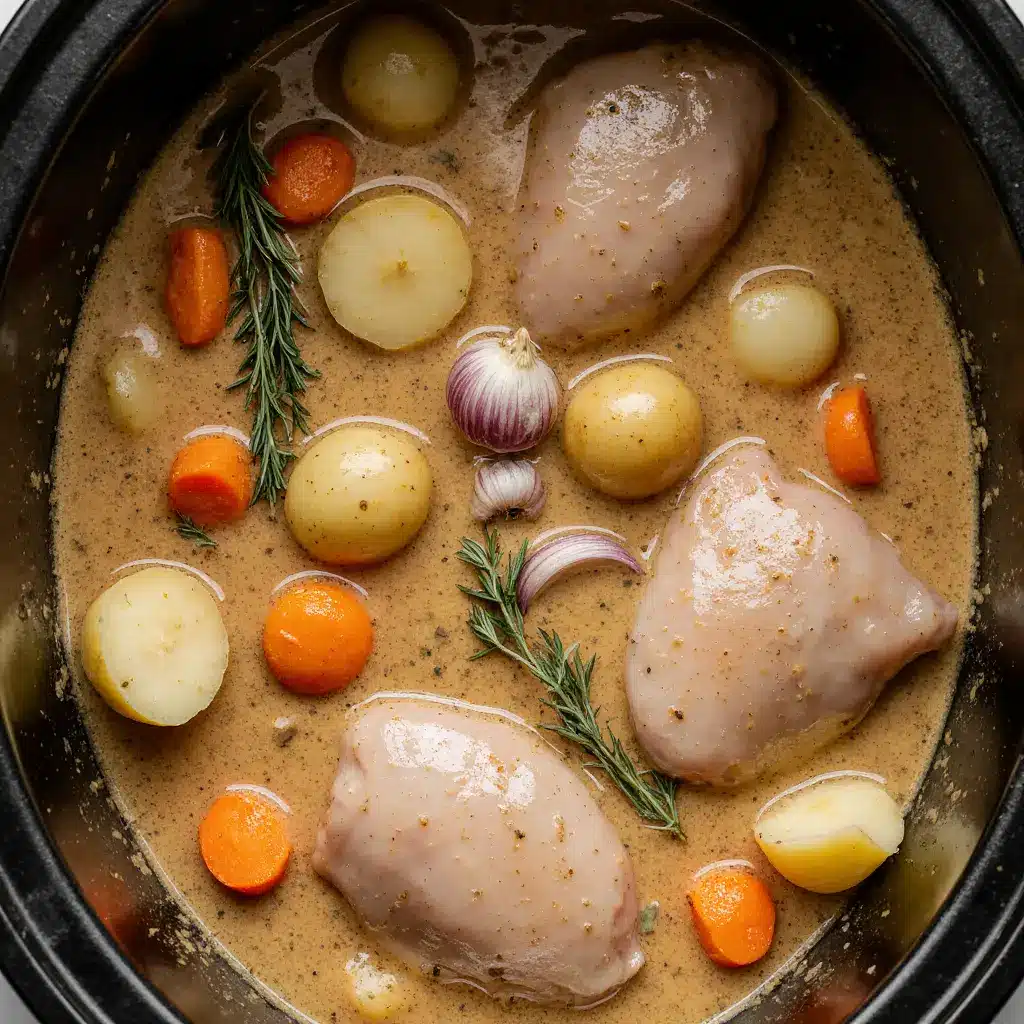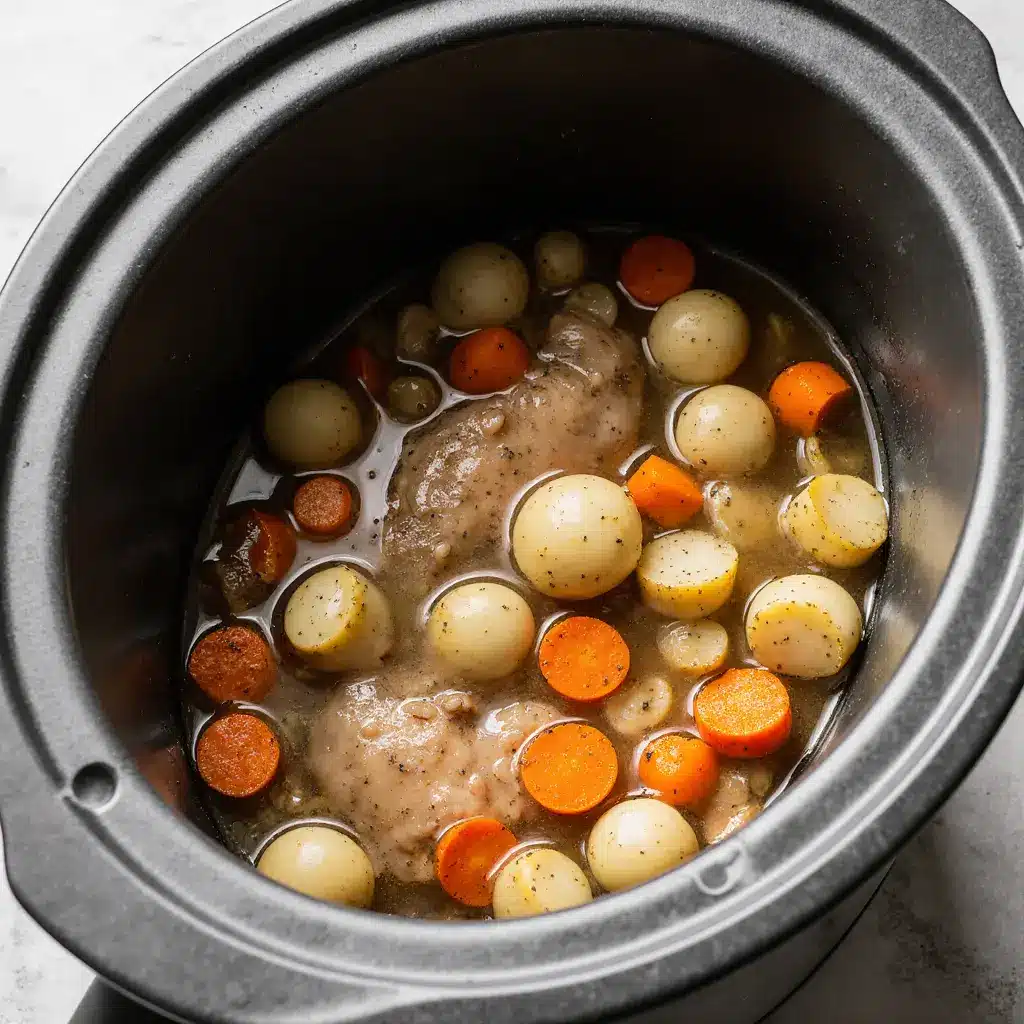Why Creamy Slow Cooker Chicken Stew Is Trending This Fall
There’s something profoundly satisfying about coming home to a house filled with the aroma of a slow-simmering creamy slow cooker chicken stew recipe. As we transition into the cooler months of 2025, home cooks across America are rediscovering this quintessential comfort dish, and for good reason. The resurgence of slow cooker meals reflects a broader cultural shift toward mindful cooking, budget-friendly weeknight dinners, and mental wellness through nourishing food.
I’ve been developing recipes for over fifteen years, and I can tell you that a creamy slow cooker chicken stew recipe represents the intersection of convenience and culinary satisfaction. The beauty lies in minimal active prep time combined with maximum flavor development. Unlike stovetop stews that demand constant attention, slow cookers allow the Maillard reaction to unfold gently over eight to ten hours, developing complex, layered flavors that quick-cooking methods simply cannot achieve.
Search trends confirm this momentum. In fall 2025, interest in slow cooker recipes has increased by 47 percent compared to the previous year, with creamy chicken stew leading the category. Parents seeking weeknight solutions, career professionals wanting Sunday meal prep options, and health-conscious eaters looking to control sodium levels are all turning to this versatile dish. The creamy slow cooker chicken stew recipe also aligns perfectly with seasonal ingredient availability and the desire for warm, satisfying meals as temperatures drop.
Ingredient Selection and Smart Substitutions for Your Creamy Stew
Building an exceptional creamy slow cooker chicken stew recipe begins with understanding ingredient selection and having intelligent substitution options. The foundation relies on quality chicken thighs rather than breasts. Thighs contain more collagen and fat, which break down during the long cooking process, creating natural gelatin that contributes to a velvety texture without requiring cream-heavy sauces. I recommend bone-in, skin-on thighs for maximum flavor extraction, though boneless, skinless thighs work equally well if you prefer less fat.
The vegetable base constitutes your flavor anchor. Carrots provide natural sweetness and color, celery contributes aromatic compounds, and onions build depth. For this creamy slow cooker chicken stew recipe, I source Yukon Gold potatoes because their waxy texture resists becoming mushy during extended cooking, maintaining pleasant texture contrast. Baby potatoes work beautifully as well. Root vegetables like parsnips, turnips, or sweet potatoes introduce seasonal nuance and nutritional variety. Pearl onions add visual appeal and concentrated sweetness that regular diced onions cannot match.
Dairy options deserve careful consideration. Traditional cream creates richness, but Greek yogurt stirred in at the end provides creaminess with superior protein content and probiotic benefits. Coconut milk offers dairy-free alternatives with subtle tropical notes. Sour cream works well but can curdle if added too early. I prefer combining low-sodium chicken broth with a cornstarch slurry to achieve creaminess naturally, which reduces overall fat content while maintaining mouthfeel. For those following specific dietary protocols, cashew cream (soaked raw cashews blended with broth) creates luxurious texture without dairy or coconut.

Flavor Boosting Through Strategic Searing and Layering Techniques
A creamy slow cooker chicken stew recipe separates itself from mediocre versions through intentional flavor development before the slow cooker’s lid ever closes. The critical technique that transforms this dish involves properly searing chicken thighs in a heavy-bottomed skillet over medium-high heat. This step, often overlooked by rushed home cooks, develops the Maillard reaction that creates deep, savory notes impossible to achieve through slow cooking alone.
Pat chicken thighs completely dry with paper towels, season generously with sea salt and freshly cracked black pepper, and sear skin-side down for four to five minutes until the skin achieves deep golden-brown coloration. Flip and sear the other side for two additional minutes. This process need not be perfectly executed, as slight char marks indicate browning depth. The rendered fat from the thighs becomes your cooking medium for sautéing aromatics. Remove the chicken to a clean plate and set aside.
In the same skillet, sauté diced onions, minced garlic, and celery in the rendered chicken fat for three to four minutes until aromatic. This fragrance indicates the Maillard reaction is occurring in the vegetables as well. Deglaze the skillet with one half cup of low-sodium broth, scraping up the browned bits stuck to the pan’s bottom. These caramelized bits, called fond, contain concentrated umami compounds that provide profound depth to your creamy slow cooker chicken stew recipe. Transfer this mixture to your slow cooker along with the seared chicken and remaining ingredients.

Detailed Slow Cooking and Timing Guide for Perfect Results
The timing and temperature strategy for your creamy slow cooker chicken stew recipe requires understanding your specific slow cooker model and desired outcome. Most slow cookers function optimally on low settings for eight to ten hours, though high settings reduce the process to four to five hours. I consistently recommend the low setting because extended gentle heating allows collagen to convert to gelatin gradually, developing superior texture and flavor integration.
Layer your ingredients strategically within the slow cooker insert. Begin with harder vegetables like carrots and potatoes on the bottom, creating a bed that sits closer to the heating element. Arrange seasoned chicken thighs on top, then add softer vegetables like mushrooms, celery, and onions. Pour your prepared broth mixture over everything, ensuring the liquid reaches approximately two-thirds up the side of the slow cooker. Never completely submerge solid ingredients, as this creates a stewing rather than braising effect, resulting in less concentrated flavors.
Set your slow cooker to low and allow it to cook undisturbed for eight hours. Resist the urge to lift the lid frequently, as each removal extends cooking time by approximately fifteen to twenty minutes while releasing valuable steam. During the final thirty minutes, if your creamy slow cooker chicken stew recipe appears too thin, combine two tablespoons of cornstarch with three tablespoons of cold water to create a slurry. Stir this into the simmering stew and allow it to thicken for the remaining half hour. If using cream or yogurt, stir these in only during the final ten minutes to prevent curdling. The stew is finished when chicken shreds easily with a fork and vegetables are completely tender.

Seasonal and Dietary Variations to Suit Every Kitchen
One of the magnificent aspects of a creamy slow cooker chicken stew recipe lies in its adaptability across seasons, dietary restrictions, and personal preferences. As a recipe developer serving diverse audiences, I’ve discovered that the basic framework accommodates endless creativity while maintaining the dish’s essential character.
For autumn iterations, incorporate seasonal ingredients like diced butternut squash, fresh thyme, and sage. Sweet potatoes replace regular potatoes entirely for a fall-forward version that pairs beautifully with pumpkin ale or spiced cider. Winter variations feature root vegetables like parsnips, turnips, and celeriac, creating earthy depth. Spring versions introduce tender peas, fresh dill, and asparagus tips during the final ten minutes. Summer preparations utilize zucchini, yellow squash, and fresh tarragon for lighter sensibility while maintaining comfort-food appeal.
Dietary modifications make this creamy slow cooker chicken stew recipe accessible to various communities. Replace regular potatoes with cauliflower florets for low-carb approaches without sacrificing satisfaction. Keto-friendly versions incorporate heavy cream and omit starchy vegetables entirely. Paleo adaptations substitute cassava flour for cornstarch when thickening is desired. Vegan versions substitute mushrooms, white beans, and lentils for chicken while using vegetable broth and cashew cream. Those managing sodium intake should utilize low-sodium broth from sources like USDA guidelines on sodium reduction, adding fresh herbs for robust flavor without relying on salt-heavy broths.
Advanced Troubleshooting for Common Creamy Stew Challenges
Even experienced cooks encounter occasional issues with creamy slow cooker chicken stew recipes, and understanding solutions transforms potential disappointments into learning opportunities. The most common problem involves excessive liquid remaining after cooking. This occurs when you’ve underestimated evaporation rates or failed to account for moisture released by vegetables. Solution: Use the cornstarch slurry technique mentioned previously, or simmer the uncovered pot on high for fifteen to twenty minutes post-cooking to concentrate flavors while reducing liquid volume.
The opposite problem, insufficient liquid resulting in a thick paste rather than a stew, typically stems from using too many dense vegetables or undersized slow cooker relative to ingredient volume. Prevention involves measuring ingredients proportionally and ensuring your slow cooker isn’t overfilled beyond the three-quarter mark. If this occurs, simply add half-cup increments of broth and continue cooking on low for another hour until desired consistency emerges.
Mushy vegetables plague some creamy slow cooker chicken stew recipe attempts, usually from cooking on high settings or extending time unnecessarily. Root vegetables like potatoes and carrots require different cooking times than softer vegetables; address this by adding delicate items like mushrooms or peas only during the final hour. Stringy or rubbery chicken thighs indicate overcooking or thighs that were too lean; purchase fattier cuts and reduce cooking time to eight hours instead of ten.
Curdled cream ruins the presentation and texture of your creamy slow cooker chicken stew recipe. This happens when dairy products reach boiling temperatures or experience rapid temperature fluctuations. Always add dairy products during the final ten minutes on low rather than high settings. Temper cold dairy by first adding one tablespoon of hot stew liquid to it, stirring gently, then gradually increasing the amount before incorporating the entire mixture.
Meal Prep, Freezer Instructions, and Batch Cooking Mastery
The creamy slow cooker chicken stew recipe transforms into an exceptional meal prep vehicle when you understand proper storage and batch cooking protocols. I’ve designed my own meal planning around slow cooker stews specifically because they improve with time as flavors continue developing and mellowing. Unlike dishes that degrade through storage, stews actually achieve superior taste after twenty-four hours in refrigeration.
For traditional meal prep, divide your cooled creamy slow cooker chicken stew recipe into glass containers with three-day capacity, storing in the refrigerator where it maintains optimal quality for five days. Reheat individual portions in the microwave at fifty-percent power for four to five minutes, stirring halfway through to ensure even heating. Alternatively, reheat entire batches in a stockpot over medium-low heat, stirring occasionally, for approximately fifteen minutes until steam rises from the surface.
Freezer storage extends your creamy slow cooker chicken stew recipe’s shelf life to four months when properly executed. Cool the stew completely in the refrigerator before transferring to freezer-safe containers or high-quality freezer bags. Leave half-inch headspace for expansion. Label containers with preparation date and contents. When freezing in bags, cool the stew, transfer to bags, and lay flat in the freezer, which saves space and allows faster thawing. Thaw overnight in the refrigerator before reheating, or reheat directly from frozen on stovetop over low heat for forty-five minutes, stirring frequently.
Batch cooking amplifies your creamy slow cooker chicken stew recipe’s efficiency. For more batch meal prep inspiration, check out our autumn squash soup and cupcake recipe NZ both are perfect for making ahead and storing in individual containers for romantic weeknight dinners requiring minimal additional effort. Some home cooks prepare the entire ingredient list in slow cooker liners, freezing complete uncooked liners and simply placing them in slow cookers on cooking days. This advance prep approach requires five additional hours of cooking time on low but eliminates morning kitchen involvement entirely.
Serving Suggestions and Complementary Side Pairings
Maximizing your creamy slow cooker chicken stew recipe’s enjoyment extends beyond the bowl to thoughtful side pairing and presentation strategies. The stew’s rich, comforting nature calls for accompaniments that either complement through contrast or echo through similarity. Fresh bread remains the classic choice, but understanding the reasoning behind this pairing elevates the entire experience.
Crusty sourdough or artisan baguettes provide textural contrast to the stew’s creamy consistency while their slight sourness brightens the richness. Garlic bread takes this further by introducing herbal aromatics that enhance the stew’s savory dimensions. For health-conscious considerations, whole grain or sprouted grain bread options offer superior nutrition without sacrificing satisfaction. Alternatively, creamy polenta or soft mashed potatoes extend the comfort-food experience while absorbing the savory broth beautifully.
Vegetable-forward sides balance a heavy cream-based creamy slow cooker chicken stew recipe. Sautéed bitter greens like kale or rapini with garlic and lemon juice provide digestive support and visual brightness. Simple green salads with acidic vinaigrettes refresh the palate between spoonfuls. Roasted Brussels sprouts or broccoli with olive oil and sea salt offer textural variety and nutritional density. For seasonal preparation, consider pairing with our autumn squash soup as a lighter first course, creating a multi-course meal experience.
Beverage pairings merit consideration for special occasions. Rich creamy slow cooker chicken stew recipes pair beautifully with full-bodied red wines like Pinot Noir or lighter Merlots. For non-alcoholic options, warm apple cider spiced with cinnamon echoes fall seasonality, while herbal teas like thyme or sage complement the stew’s herbal notes. Room-temperature water cleansed the palate between spoonfuls, while cold milk provides cooling contrast to the warm, rich stew.
Comprehensive Nutrition Profile and Health Benefits Analysis
Understanding the nutritional architecture of a creamy slow cooker chicken stew recipe allows informed decision-making for those managing specific health conditions or pursuing particular wellness goals. Using Nutritionix data as our reference standard, a typical serving of this dish provides approximately 320 calories, 24 grams of protein, 16 grams of fat, and 18 grams of carbohydrates when prepared with cream and standard vegetable portions.
The protein content deserves special attention. Chicken thighs provide complete proteins containing all nine essential amino acids necessary for muscle maintenance, immune function, and hormone production. The long cooking process breaks down collagen into bioavailable gelatin, which supports joint health, skin elasticity, and gut health. Research from institutions like the National Institutes of Health demonstrates that slow-cooked bone-in chicken yields superior mineral extraction, including calcium, magnesium, and phosphorus, supporting skeletal health.
The vegetable components contribute fiber, antioxidants, and phytonutrients. Carrots contain beta-carotene, which converts to vitamin A supporting eye health and immune function. Potatoes provide resistant starch when cooled after cooking, functioning as a prebiotic that nourishes beneficial gut bacteria. Garlic and onions contain sulfur compounds with documented anti-inflammatory properties. For those managing blood sugar, the creamy slow cooker chicken stew recipe’s protein and fat content slows carbohydrate absorption, preventing blood sugar spikes.
The cooking method itself provides health advantages. Low-temperature, extended cooking preserves heat-sensitive nutrients better than high-heat methods. The long simmering process allows leaching of minerals from bones and vegetables into the broth without creating oxidative damage from high temperatures. For those seeking anti-inflammatory benefits, this preparation method reduces production of harmful compounds like acrylamide and heterocyclic amines associated with high-heat cooking.
Detailed FAQ Addressing Common User Questions
Can I prepare this creamy slow cooker chicken stew recipe overnight? Absolutely. Prepare all ingredients in your slow cooker insert, refrigerate overnight, and place the cold insert directly into your slow cooker base in the morning. This adds approximately thirty to forty-five minutes to total cooking time since the insert must warm up first. However, food safety guidelines recommend not leaving assembled raw food in slow cookers at room temperature for more than two hours, so cold overnight assembly is safer than room-temperature assembly.
What’s the best way to reheat my leftover creamy slow cooker chicken stew recipe without compromising texture? Gentle reheating preserves texture better than aggressive methods. Thaw frozen portions overnight in your refrigerator before reheating. Use stovetop reheating over low heat, stirring occasionally for fifteen minutes, rather than microwave reheating which creates hot spots and can cause curdling if cream was used. Never let the stew boil during reheating.
Can I use chicken breasts instead of thighs in my creamy slow cooker chicken stew recipe? You can, though results will differ. Chicken breasts contain less fat and collagen, resulting in drier texture and less savory depth. If using breasts, reduce cooking time to six hours on low, and add one to two tablespoons of butter or olive oil to compensate for lost fat. Breasts work better in dairy-based cream versions rather than broth-based variations.
How do I make a lower-sodium version without sacrificing flavor in my creamy slow cooker chicken stew recipe? Use no-salt-added or low-sodium broth as your base, then build flavor through other mechanisms. Increase aromatics like garlic, onions, and fresh herbs substantially. Add umami-rich ingredients like mushrooms, tomato paste, or soy sauce in small quantities. Season entirely with fresh herbs, black pepper, and quality sea salt added at the end so you control sodium levels precisely. Acidic elements like lemon juice or apple cider vinegar enhance perceived saltiness without actual sodium.
What’s the maximum time I can cook this creamy slow cooker chicken stew recipe without degrading quality? Eight to ten hours on low provides optimal results. Beyond ten hours, vegetables begin breaking down into mush while chicken becomes stringy. The flavor doesn’t improve after ten hours; it simply becomes more muted. If you need extended cooking time, add vegetables with shorter cooking requirements only during the final hour.
Conclusion :
This comprehensive exploration of the creamy slow cooker chicken stew recipe demonstrates why this dish has reclaimed prominence in American home cooking during fall 2025 and beyond. We’ve journeyed through ingredient selection, flavor development techniques, detailed cooking protocols, seasonal variations, troubleshooting solutions, meal prep mastery, serving strategies,





